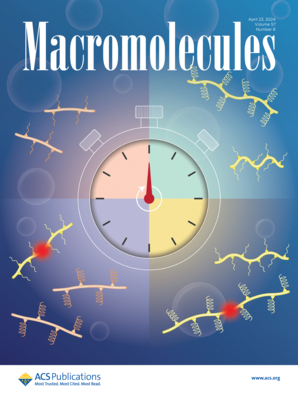Synthesis, Voltammetry, and Spectroelectrochemical Characterization of Tunable Ferrocene-Jeffamine Redox-Active (Co)polymers: Controlling Redox and Ionic Interactions Through Composition
IF 5.1
1区 化学
Q1 POLYMER SCIENCE
引用次数: 0
Abstract
There is a critical need for predictably modulating the reactivity of redox-active polymers (RAPs) to improve their performance in applications such as catalysis, energy storage, and sensing. However, few studies systematically modify the redox loading through copolymerization to understand the impact on the polymer electrochemistry. In this study, we developed a series of (co)polymers incorporating redox-active ferrocene motif and nonredox-active, polyethylene glycol-type Jeffamine diluent, using ring-opening metathesis polymerization (ROMP). The redox activity and charge transfer characteristics of the resulting (co)polymers were successfully modulated by systematically varying the ratios of the two monomers, where elemental analysis and ultraviolet–visible (UV–vis) spectroscopy quantitatively confirmed their composition. Cyclic voltammetry (CV) analysis of films deposited and operated in different conditions for samples synthesized with 25% to 100% of the ferrocene repeat unit confirmed the ability to fine-tune redox behavior, including interchain interactions. Furthermore, experiments at varying ionic strength and (co)polymer composition revealed distinct interactions with ions in the supporting electrolyte, as probed via in situ infrared spectroscopy. The behavior of polymers in solution, characterized via bulk electrolysis and UV–vis spectroscopy, was compared to that in films, highlighting the role of Jeffamine in decreasing interactions responsible for distortions in the film CV and polymer insolubility in their oxidized form. This approach of incorporating nonredox-active monomers to modulate redox and ionic interactions could be applied to other combinations of polymers and redox-active molecules, offering a strategic approach to tailor properties such as solubility, charge accessibility, and rate in redox polymers for diverse applications.

求助全文
约1分钟内获得全文
求助全文
来源期刊

Macromolecules
工程技术-高分子科学
CiteScore
9.30
自引率
16.40%
发文量
942
审稿时长
2 months
期刊介绍:
Macromolecules publishes original, fundamental, and impactful research on all aspects of polymer science. Topics of interest include synthesis (e.g., controlled polymerizations, polymerization catalysis, post polymerization modification, new monomer structures and polymer architectures, and polymerization mechanisms/kinetics analysis); phase behavior, thermodynamics, dynamic, and ordering/disordering phenomena (e.g., self-assembly, gelation, crystallization, solution/melt/solid-state characteristics); structure and properties (e.g., mechanical and rheological properties, surface/interfacial characteristics, electronic and transport properties); new state of the art characterization (e.g., spectroscopy, scattering, microscopy, rheology), simulation (e.g., Monte Carlo, molecular dynamics, multi-scale/coarse-grained modeling), and theoretical methods. Renewable/sustainable polymers, polymer networks, responsive polymers, electro-, magneto- and opto-active macromolecules, inorganic polymers, charge-transporting polymers (ion-containing, semiconducting, and conducting), nanostructured polymers, and polymer composites are also of interest. Typical papers published in Macromolecules showcase important and innovative concepts, experimental methods/observations, and theoretical/computational approaches that demonstrate a fundamental advance in the understanding of polymers.
 求助内容:
求助内容: 应助结果提醒方式:
应助结果提醒方式:


